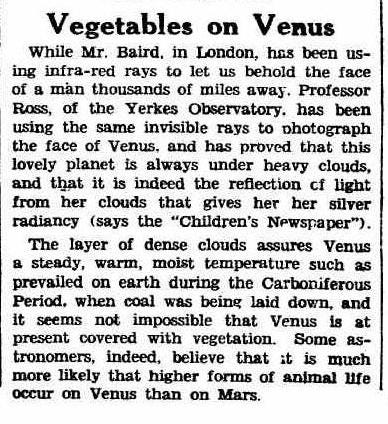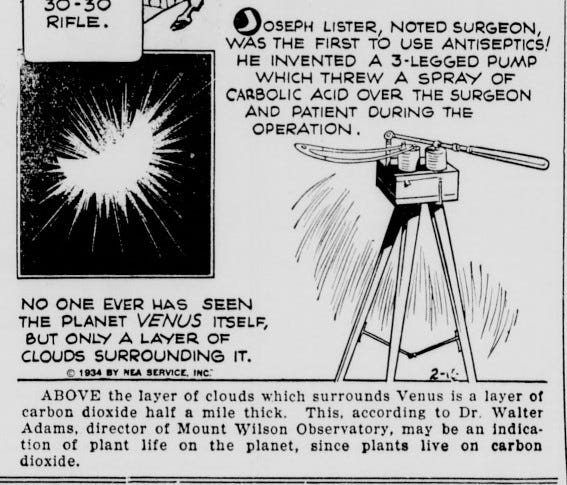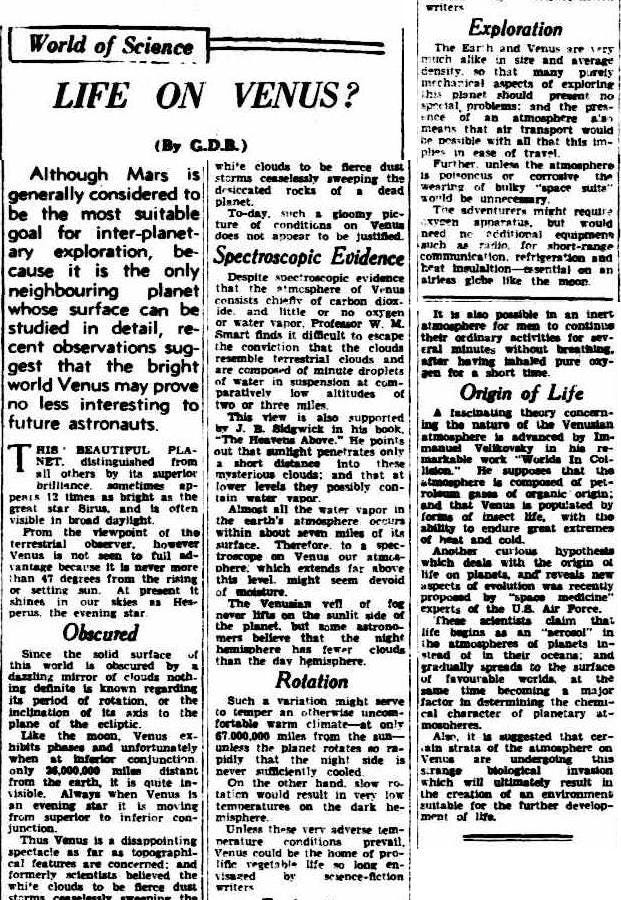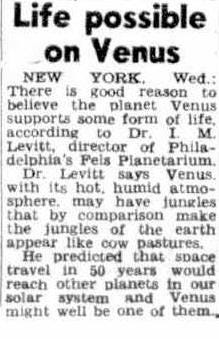'The Science' said there was life on Venus. So what happened?
Endless propaganda, now silence. Venus is not a woman. It is not a maiden. It may well have been a comet.
Scientism is the religious belief in the overpowering majesty and divine right to rule of ‘Science’ whatever that may mean. This ‘Science’ utilises the magic of experiments, either real or fraudulent, tooled with complicated technology, expressed with complex words embedded within treasured treatises suffused with complex mathematical hieroglyphics to impress upon the laity its opulent magnificence and godly powers. The artifacts of ‘The Science’ can only be divined by the priestly caste of those educated in the arts of entrail divination and the translation of oracle-whispers into commandments. It is not for the hoi-polloi to question the priestly caste.
Dinosaurs on Venus: Daily Herald - Friday 29 September 1961 (‘No scientific reason why some form of animal life should not have evolved on Venus…with wings…’)
From 1910 to about 1955, ‘The Science’, or the religious imperative of ‘Scientism’ embarked on a ceaseless propaganda war to convince the masses that life existed on Mars and Venus. There was some dissent. Some articles from that era believed life was impossible. Some claimed that Venus was too close to the Sun (about 60 million miles) and too hot with a surface temperature of 115 F. In reality, the surface is about 1000F. But much of the Science-media proclaimed the likelihood that some form of life existed.
Velikovsky, who attempted to provide cosmological proof for the miracles of the Old Testament and to reinterpret Greek mythology using cosmological events, for some reason believed that Venus’ atmosphere was full of insects. Others believed that vegetation was flourishing. Many wondered if Venus and not Mars was more likely to have advanced civilisations. Evolutionists predicted that even if no life existed on the planet, it was sure to flourish soon given its chemical composition. UFO believers cited Venus to be a pirate haven of violent aliens who at times terrorised earth. Fiction writers in the 1950s described Venus as a friendly, green planet, with advanced technology.
In reality, Venus is hell, not a lovely woman, (Aphrodite is the goddess of love and the moon, not Venus), and you don’t hear much about Venus today. ‘The Science’ never apologised for its previous positions. It ignores much about Venus – why is it an immature planet, why after billions of years hasn’t it cooled, why after billions of years is its atmosphere so primitive, why do the ancients discuss Venus (Athena) fighting with both the Earth (Hera) and Mars (Ares)? Why is Venus so low on the horizon when the ancients say it was active and high in the sky? Why is Venus so hard to see now and not as bright as before? Why doesn’t Venus appear in ancient astrological records before the 1rst millennium BC when Mars, Jupiter, Saturn and the Moon are known and revered? ‘The Science’ does not care.
‘The Science’ has simply moved on from Venus and with billions of dollars at issue, is now via SETI and various ‘space’ programs, intent on finding life elsewhere and solving the riddles of the universe, journeying to the dead cold Mars once trumpeted as a superior civilisation and searching for the non-existent ‘dark matter’ to make its equations balance. In reality we are largely ignorant about what is under our own feet. How did hydrocarbon energy become so plentiful and why is gold only deposited near the surface? Why the obvious signs of catastrophism, why are there marine fossils on Everest? These and 1000 other questions still loom. Maybe ‘The Science’ can start with our own planet.
Life on Venus, all hail
The World’s News, August 15 1928, p. 38 NSW Gazette, “…that it is much more likely that higher forms of animal life occur on Venus than on Mars”
Life on both Mars and Venus (1931)
“Moreover, Venus is quite modest, because she always has a rather heavy veil of clouds around her. Mars, on the other hand, in spite of the fact that he is much smaller than Venus and also farther away, can be observed quite nicely thru a telescope. The astronomers are quite certain that at the poles of Mars there are ice caps which melt at certain times of year. There is a strong probability that some kind of life exists both on Mars and Venus, although the living conditions are necessarily far different from what they are on the earth.”
1928: Vegetables on Venus
1934: Planet Life on Venus
June 8th 1954: Evolutionist says life coming any second now on Venus
1932: A professor predicts life on Venus
Velikovsky and some scientists discuss insects on Venus: 1953
Venus is the source of UFOs, 1954:
1954: By 2004 we would be travelling to Venus and view life
It is evident that ‘The Science’ is rather purblind in many cases. Some humility might be in order.














I vaguely recall all this speculation from being a child interested in astronomy. We can’t see anything on Venus, so the planet is clearly a tropical jungle populated by dinosaurs, lol. The Venera probes revealed the shocking truth. However, all was not lost for the climate zealots were able to demonstrate a “runaway greenhouse effect” that has infected our lives ever since. Thanks for the article and the research.